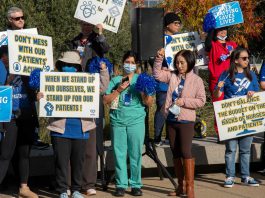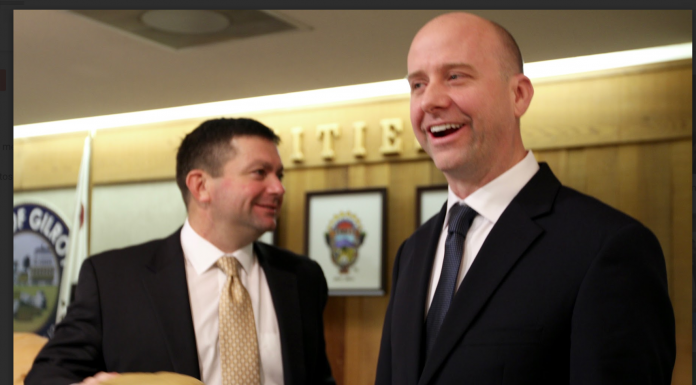Councilman’s First 100 Days
“The learning curve is very steep,” said Daniel Harney, regarding his first 100 days as a member of the Gilroy City Council.Selected to fill the vacancy following former mayor Don Gage’s retirement in December, Harney stepped up to the dais Jan. 25.Not one to sit back and watch everyone else at work, over the course of the last three months the eBay executive, husband and father of two helped select new City Administrator Gabriel Gonzalez as a member of the selection subcommittee and supported the city’s move to join the Silicon Valley Clean Energy Authority, becoming Gilroy’s representative on that initiative’s governing board in the process.“Gilroy is the fourth-largest energy consumer in the county and joining the SVCE authority provides our city the ability to purchase electricity from a higher percentage of renewable energy sources, helps lower Gilroy’s greenhouse gas emissions and gives our residents more consumer choice—versus PG&E,” said Harney.“More importantly, it sends a clear and direct message to other Silicon Valley cities that Gilroy will be a leader when it comes to sustainability and resolving shared problems in our county.”Messaging is a major concern for Harney, who feels the city suffers from a problem of misperception based on misinformation.“When I’m out speaking with people, they tell me they don’t go downtown because of the crime problems downtown. Some of the lowest crime rates are downtown,” said Harney.“There is a ton of misinformation out there and there is a lack of dialogue. People have a perception of something; they hold on to that perception and then it becomes a reality. Communication, different channels of communication, can change all that.”Harney said he would like Gilroy residents to be excited and proud of their city.“Gilroy is experiencing somewhat of a renaissance. Our population is becoming more diverse, culturally and demographically. Our wine and tourism industry continues to grow; our downtown and industrial vacancies are much lower than in recent years.”While there are problems—“our roads may not be in the best condition and our growth plan is not resolved,” Harney stresses that Gilroy “is heading in the right direction” and that residents must not lose focus on the fundamentals, to “remain financially sustainable, grow our economy, upgrade our city infrastructure and create a livable community for all.”Many of the issues Gilroy is currently grappling with are not unique to the southernmost city in Santa Clara County.“Many neighboring Silicon Valley cities face the same problems that we are facing, including water, transportation, deteriorating road conditions and planning for high speed rail,” he said. “We need to ensure that we are properly positioned and represented in many of the Santa Clara County cooperatives that help resolve issues with growth.”As for the debate over the proposed urban growth boundary (UGB) initiative brought by the citizen action group Gilroy Growing Smarter in reaction to the contentious 721-acre Rancho Los Olivos housing project formerly proposed for land north of the city, Harney admits the “community remains divided on how and when to grow.“Understanding the key issues of the UGB is important and is why I supported the decision to fund an independent analysis of the impacts to schools, housing, traffic and the fiscal impact this change may have on the city.”At the April 18 City Council meeting, the council approved a further $75,000 to fund an independent report on the impacts of the citizen-led UGB initiative, bringing the total approved funding to $150,000.
Editorial: Just Say No to Gun Shop
A proposal to put a gun shop downtown in the building that used to house the Pinnacle newspaper has gotten mixed reviews from the community.Some say we need all the merchants we can get downtown. Anything is better than the vacant and boarded up buildings we have now.Others worry about the image it would make in a downtown that is striving to match those of Morgan Hill or Los Gatos, as a place to bring families, with a mix of retail, restaurants and entertainment that would entice out-of-towners to what should be one of the most quaint and authentic downtowns in the Bay Area.It’s funny that we get tourists from Los Angeles who think of Gilroy as a must-see. Garbo’s, the successful antique store, started out advertising down south and got a huge response from travelers looking to venture into a town that still has a historical, agrarian feel. They liked what they found here, even as they thumbed their noses at some of their own small towns.“I found out that when you mentioned Gilroy in San Francisco, people went, ‘eww,’ but in L.A., they think Gilroy is charming. Of course, they don’t like Pomona,” said Bruce Dane, Garbo’s owner.So, some might argue, a gun shop could bring more authenticity and a Wild West feel. We buy that, to an extent. Something about it just makes us bristle.Is that really the best location for a heavily secured store where people are going to buy weapons? Is that the image you want people to take away from Gilroy? Do we want to be the weapons capital of the South Valley?There’s Predator’s Archery on the right, a nice gun shop on the left and over there down the street is a nuclear warhead shop. And, as wag Jack Foley said, we could turn the carpet store into a carpet bomb store.We don’t want to come off as radically anti-gun. There are plenty of local hunters and there are an estimated 270 million guns in this country, or 89 for every 100 residents, based on a Swiss study. They aren’t going away anytime soon. There are also already eight permitted places in Gilroy you can buy a gun. These are home businesses and most people are unaware of them.We know that a gun store goes through strict permitting processes. Police are involved to make sure the place is safe. Despite that, nationwide, there are plenty of shooting incidents in gun stores, even one in 2011 at Watsonville’s Big 5.All that said, it comes down to a question of image and perception. Mayor Perry Woodward—a hunter—says the store could bring shoppers here who now have to travel to other cities to buy their rifles and handguns. But Woodward also says he wants to see a time when people in Morgan Hill, which keeps getting more and more upscale, envy Gilroy’s downtown.Is a gun store, rather than, say, an Apple store, something that would make our downtown sizzle, especially across the street from what the mayor hopes will be a family plaza for entertainment?Gilroyans have said no to downtown adult bookstores and marijuana shops, even though they are legal in other cities. They don’t want children looking in store windows and getting the wrong messages. We think they should apply the same standards to weapons. Keep them safe and tucked away, not glorified downtown near the parades and concerts and the ceramics studios and sewing stores.
Gilroy Teacher had Previous Complaint
A Gilroy woman said she alerted Gilroy High School officials and police more than a year ago to sexual texts sent by Gilroy High School science teacher Doug Le—who was arrested April 26 on suspicion of soliciting lewd pictures from minors—but nothing was done.
Is Gilroy Getting Better for Business?
Gilroy has lost small businesses to other cities and frustrated others with what’s seen as hostility and over-regulation that created a seething cold war between City Hall and Main Street.It’s too late for merchants who fled or closed, but new signs point to a possible ceasefire, a thaw, more cooperation and a revitalization of what has been an ailing historic downtown business district.“There was a time when all you had to do was look at anybody from the city and the answer was no, or the answer was so obviously unhelpful you did not know how to proceed,” said Linda Williams, who quit her job in biotech and, with no retail experience, bought the long-established Nimble Thimble Quilt Shop and moved it into an aging downtown storefront she purchased and renovated at 7455 Monterey Road.Now, she said, “I am starting to change my mind, I am guardedly optimistic.”Downtown activist Gary Walton has done business in Gilroy for 30 years. He, too, detects a change for the better.“I have a lot of faith, I am actually optimistic about downtown,” he said, two days after showing a prospective new downtown businessman around.It’s time for the city and merchants to pull together and stop being adversaries, according to Walton.“If the city staff understands this is a partnership, rather than ‘we need to control those dirty bastards and make them crawl through broken glass,’ we are going to do a lot in the future,” he said.What has been so frustrating, he said, is “the city has absolutely no road map that tells how to get a permit, no timelines for the process. Other cities have flow charts for the process. If Gilroy would clearly spell out the steps and give you a road map and tell you how long it takes, instead of it all being hit and miss.”Merchants complain that the city doesn’t provide much help getting through a maze of rules and point to a lack of help from city staff—concerning permits for signage, expansion, licensing and earthquake safety—making it extremely complicated to open a mom and pop store.Examples of discord reveal a continuum of clashes that have pitted the city against merchants for years, most notably during the reigns of former city manager Tom Haglund and former Mayor Don Gage, according to some critics.Gage has been accused in the past of trying to force his esthetic likes and dislikes down the throats of a unhappy merchants with repressive design standards and bans on certain types of businesses.He and Haglund resigned last year and relieved and hopeful merchants point to other changes in key city positions that could augur a newer, kinder relationship with the merchant community.Take auto-related businesses, for example, which Gage repeatedly tried to ban from the downtown while encouraging them along the freeway. The city has since backed off on that downtown restriction, according to Walton.But not before there was damage. With a small desk, filing cabinets and a phone—nothing that smacked of the automobile industry—John Trinchero ran a successful car wholesale business at a 7810 Monterey Street storefront for 23 years until 2012.His family ran businesses in town since the 1920s, including its first pizza parlor and the old Hecker Pass Inn that fed diners for 50 years on First Street.At 73, Trinchero wanted to retire and for two years tried to turn the business over to his European university-educated son.But that required a new business license for the proposed new ownership, the city told him, which would trigger a city law that at the time banned auto-related businesses in the downtown that did not exist before its passage, according to Trinchero, now 77.He reluctantly closed shop and retired and his son returned to Europe. He still is bitter.“Opening a small business in Gilroy and getting the city to let you operate after you open is near impossible,” Trinchero wrote about the situation. “Dealing with city employees who seem to be trained to keep small businesses [tied up] with so much red tape you just give up,” he wrote.In an interview this week he said, “These are just mom and pop businesses, but you can’t get any help from the city.”Another merchant said her sales fell 20 percent and she was threatened with fines when the city enacted a new sign ordinance that many found overbearing.“They try to squeeze money out of you any way they can,” she said of the citations and regulations.She opposed the Gage-led Measure F, a proposed city sales tax hike that voters rejected last year, wondering why people would buy in Gilroy if the tax had passed.She and her husband wanted to purchase and renovate an old building for their business and met with city leaders, but were so badly treated they gave up and opted for Morgan Hill, she said. New city leadership is no better than the old, she said, calling Gilroy “a nightmare” to deal with.“When Walmart came in the city waived so many things, but for small businesses they won’t waive anything,” she said. “I love Gilroy, but for a small business Morgan Hill is much more embracing, they were welcoming.”She asked not to be identified, fearing retaliation by the city if she ever tries to return.Walton was not surprised. Her reaction, he said, “is not unusual. It is really sad when people fear their government, it shows that people feel that it is corrupt and not fair.”At Predator’s Archery on Monterey Road, a half-block south of the iconic Old City Hall, owners Curtis Campisi and Mike Pierce have in 23 years turned a $10,000 investment into an international business that grosses $1.1 million a year and employs a half-dozen people. Among the state’s 25 archery dealers, it ranks fourth in sales, Campisi said.When they tried to expand into a next-door storefront for a second indoor archery range, they were shocked by the city’s response.The city halted the project, demanded a new, wooden design to meet historic standards and slapped them with an additional $4,000 permit fee for being in a historic district.That brought the fees to $8,000 on a project budgeted to cost $5,000, Campisi said. And when it came to knowing exactly how to proceed, the city was no help, the Gilroy native said.“They need a resource liaison, someone who will hold [applicants’] hands and tell them the guidelines,” Campisi said.After more meetings, Campisi seems confident that at least some of the fee will be reduced. Still, he questioned the $4,000 fee and what it actually pays for.At the Nimble Thimble, Williams said ending friction between the city and merchants boils down to keeping the lines of communication open.“I really do think in the last six months things have gotten much, much better,” she said.In spite of what she was put through, Williams said, “I am glad I did it. I moved from Pasadena to Gilroy and I love it. I want to be part of downtown and I want it to be a good town, the kind I want to live in—we just have some things to figure out.”Walton is determined to figure out and fix things and, characteristically, is operating beyond the city’s reach to do so.He is forming a design committee made up of professionals who will voluntarily assist merchants with their issues, to fill the void he believes has been created by a city staff and leadership that has not been people- or business-friendly.The committee will prepare merchants before they ever approach the city, Walton said.Small businesses are the backbone of the economy, he said, citing studies that show cities that welcome and help them are more economically vital than those that don’t. Indeed, downtown merchants as a group are one of the city’s largest employers, he said. The welcoming must start at the top, Walton continued. The smooth to rough cycles the city goes through in dealing with merchants are tied to its leadership, and it’s the tone of that leadership that is reflected in the way the staff handles small businesses, he said.“You have to be business-friendly in order to accomplish the economic development this community needs; there is an inverse relationship between the amount of regulation and amount of business in a community,” he said.But there are signs that things indeed are improving, according to the longtime businessman.In his tireless efforts to attract businesses to town, Walton last Saturday walked through several vacant stores with a bookshop owner contemplating relocating his store from Mountain View to Gilroy. A top city planning staffer showed up to help.“On her own time,” Walton said. “That is a good sign.”
Gilroy Police Seek Students’ Design for New Charger
Gilroy Police Department is seeking assistance from local High School students with the design of one of our new School-Resource-Officer (SRO) patrol cars. The vehicle, which was donated by Gilroy’s South County Chrysler-Dodge-Jeep-Ram Dealership, is a 2015 Dodge Charger which is pictured above.
Poppy Support
Mayor and US Navy veteran, Perry Woodward, is presented with the first poppy of the annual poppy appeal fundraiser held by the American Legion Auxiliary Gilroy Unit 217 during the month of May, by poppy chairwoman, Maryann Collom on Tuesday. The month-long appeal is in support of local veterans, with money going to provide things such as clothing, meals, and transportation to doctor's appointments. The poppy became a symbol of remembrance to honor fallen soldiers after World War One. Volunteers will be collecting donations in May at venues throughout the city. An enchilada dinner with rice, beans, salad and dessert will be served on Saturday, April 30, starting at 6 p.m. at American Legion Gilroy Post #217, 74 W 6th St, Gilroy. Tickets $10.
Health Food Distributor Cuts Ribbon
UNFI general manager Crystal Brennan cuts the red ribbon at the the company’s state-of-the-art distribution center in Gilroy on Tuesday. She is flanked by UNFI employees and Gilroy Chamber of Commerce president Mark Turner, Gilroy Economic Development Corporation president Tammy Brownlow, Mayor Perry Woodward and Gilroy City Councilwoman Terri Aulman.
Susan Steinmetz was Gilroy Clerk for 41 Years
It was the 1950s: Mt. Everest was conquered, Elvis and Disneyland became household names and Susanne Steinmetz went to work for the city of Gilroy in 1952. She was 15.
City Hall Upgrades and Senior Housing on the Tracks
Mayor Perry Woodward opened Monday’s Gilroy City Council meeting by presenting honorary certificates to Joel Goldsmith, Terri Neidigh, Alex Salinas and Claudia Salinas for their “heroic lifesaving efforts.” The quick-thinking good samaritans rushed in to perform CPR on Joe Lomeli on Feb. 26 when the 75-year-old retired AT&T engineer suddenly collapsed at Snap Fitness. The full story can be found here: http://bit.ly/241vW72.
















